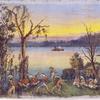Mary Margaret 'Moo' Anderson, Pioneering Art Collector and Museum Donor, Remembered
- October 24, 2019 17:34
Art collector Mary Margaret “Moo” Anderson died Oct. 22 at her home in the San Francisco Bay Area, reports Stanford News. She was 92.
Boston-born Moo Anderson was known for amassing a significant collection of post-World War II American art with her late husband, Harry "Hunk" Anderson (d. 2018). After 50 years of collecting, the couple, and their daughter, Mary Patricia “Putter” Anderson Pence, pledged premier examples of 20th-century American art to Stanford University. In 2014, a new $30 million building by Ennead Architects opened for the Anderson Collection at Stanford University with 121 works by 86 artists, one of the greatest art gifts ever donated to a U.S. institution.
“I think in order to enjoy art, you have to share it,” Moo said.
Featuring notable examples of the New York School and Bay Area Figuration, the collection spans Abstract Expressionism, Color Field Painting, Post-Minimalism, California Funk Art, and Light and Space. Artists represented include Helen Frankenthaler, Franz Kline, Morris Louis, Agnes Martin, Joan Mitchell, Robert Motherwell, David Park, Mark Rothko, Frank Stella and Wayne Thiebaud. Among the most prized works are Jackson Pollock’s Lucifer, Willem de Kooning’s Woman Standing – Pink, Richard Diebenkorn’s Ocean Park #60, Sam Francis’ Red in Red, Philip Guston’s The Coat II, Ellsworth Kelly’s Black Ripe and Clyfford Still’s 1957-J No. 1.
“Probably no private collection,” wrote San Francisco Chronicle critic Kenneth Baker at the time of gift, “illustrates the course of American art since World War II better than that of… Harry W. and Mary Margaret Anderson.”
Mary Margaret Ransford was born Nov. 1, 1926, and in 1950 she married Hunk Anderson. They settled in California in 1964. The couple was first inspired to collect art by a trip to the Louvre in the early 1960s. They initially fell for Matisse and Picasso, but quickly switched to postwar American artists, from Pollock to Rothko.
James Cuno, the president and CEO of the Getty Trust, once said that the Andersons “defined their field early, and pursued it with vigor and good taste.”
“Moo Anderson will forever be remembered for her love of art, but also for her love of sharing art,” said Stanford President Marc Tessier-Lavigne. “In the early days of her and Hunk’s collecting, she listened and learned from curators and art historians, and spent a great deal of time examining the artwork in museums, galleries and artists’ studios in person. She opened her home so that students could have that same experience of looking and learning about art. We are so deeply grateful that Moo and Hunk trusted Stanford to be stewards of their remarkable collection and enable people of all ages to experience it on a daily basis.”
Along with artwork, Moo developed a vast library of art books, catalogs and ephemera related to the art, artists and movements represented in the couple's collection. These resources were given to Stanford's Denning Family Resource Center.
“The Andersons’ collecting philosophy rested upon their equal belief in the head and the hands – ingenuity as well as master craftsmanship. What that doesn’t mention is both Moo and Hunk led with their hearts,” said Jason Linetzky, director of the Anderson Collection. “Moo’s gifts of passion, of warmth and of believing that great art belongs to the world will forever energize the collection and the students and guests who visit and learn from it.”
Since its founding five years ago, the Anderson Collection at Stanford University has expanded with major gifts of art from other private collectors, including contemporary works such as Mary Weatherford’s black painting, 2017.
The Andersons made additional extraordinary bequests, including works by Frank Stella, Jasper Johns, Roy Lichtenstein, Robert Indiana, Robert Rauschenberg and more, to the San Francisco Museum of Modern Art, and 655 prints to the Fine Arts Museums of San Francisco.
In November 2018, Christie's offered about 200 works from the Anderson collection, including a Philip Guston work on paper that soared to $3.13 million.
"We will always remember Moo as an incredibly strong woman, one who voiced her opinions, ensured she had equality in her marriage, and earned the respect and admiration of people from all walks of life. She was savvy, thoughtful, curious, and energetic, bringing 150% to everything she did," reads Moo's obituary. "As Hunk used to say, Moo was a tiger!"
Hunk died in February 2018. His company, Saga Corp., went public in the 1970s and eventually sold to Marriott.
Moo is survived by her daughter Mary Patricia “Putter” Pence and granddaughter Devin Diane Pence.





















